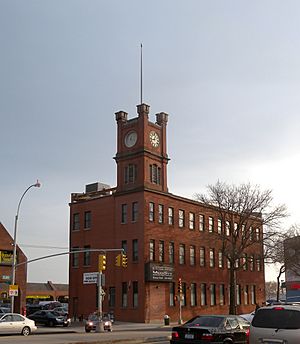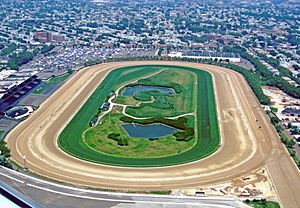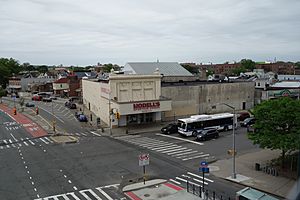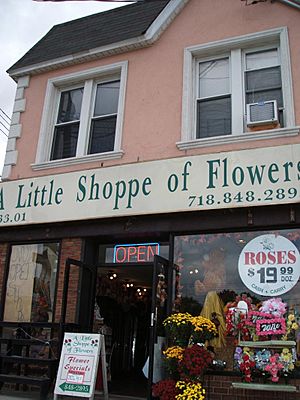Ozone Park, Queens facts for kids
Quick facts for kids
Ozone Park
|
|
|---|---|
|
Neighborhood of Queens
|
|
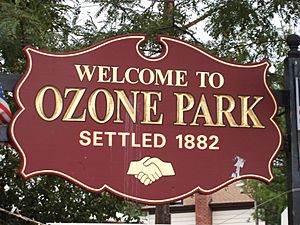 |
|
| Country | |
| State | |
| City | |
| County/Borough | |
| Community District | Queens 9, Queens 10 |
| Population | |
| • Total | 21,376 (main section only) |
| Ethnicity (Census 2010) | |
| • Hispanic | 37.9% |
| • White | 30.5% |
| • Asian | 19.4% |
| • Black | 5.6% |
| • Other | 6.6% |
| Economics | |
| • Median income | $41,291 |
| Time zone | UTC−05:00 (EST) |
| • Summer (DST) | UTC−04:00 (EDT) |
| ZIP Codes |
11416, 11417
|
| Area codes | 718, 347, 929, and 917 |
Ozone Park is a neighborhood in the southwestern part of Queens, New York City. It is located next to the Aqueduct Racetrack. This racetrack is famous for Thoroughbred racing. It is also home to the Resorts World Casino & Hotel.
Ozone Park was once home to many Italian-American families. Today, it is a diverse area. Many people from the Caribbean, Hispanic, and Asian backgrounds live here.
New York City neighborhoods do not have official borders. However, Ozone Park is generally seen as having these boundaries:
- North: Atlantic Avenue
- South: North Conduit Avenue
- West: The border between Brooklyn and Queens
- East: Up to 108th Street and Aqueduct Racetrack
The neighborhood is divided into two community districts. The southern part is in Queens Community District 10. The northern part is in Queens Community District 9. The New York City Police Department (NYPD) covers these areas. Its ZIP Codes are 11416 and 11417.
Contents
Why the Name "Ozone Park"?
The name "Ozone Park" was chosen to attract people. It suggested fresh breezes from the Atlantic Ocean. It also sounded like a park-like community.
In the 1880s, "ozone" was thought to be a healthy part of fresh air. People believed it came from mountain or sea breezes. This is different from how we think of ozone today. Today, we know ozone can be a harmful pollutant.
History of Ozone Park
Early Beginnings
Before Ozone Park, there was an area called "Centreville." It started in the 1840s. It was located around Centreville Street. The Centreville Community Church was also there. Part of Ozone Park is still called "Centreville" today.
In the 1870s, two French immigrants, Charles Lalance and Florian Grosjean, built a factory. It was in Woodhaven. They made cooking items and porcelain enamelware. The factory burned down in 1876.
Lalance and Grosjean then built a new factory. They also built about 100 houses for their workers. This was at Atlantic Avenue and 92nd Street. This area is now part of Ozone Park.
Around the 1870s, an economic downturn happened. People in New York City looked for cheaper homes. They found them in the suburbs of Manhattan and Brooklyn.
In 1880, the New York, Woodhaven & Rockaway Railroad started train service. It ran from Long Island City to Howard Beach, Queens. The Ozone Park station opened in 1883.
Two wealthy partners, Benjamin W. Hitchcock and Charles C. Denton, bought land nearby. They advertised Ozone Park as having "pure air" and "no malaria." They chose the name "Ozone Park" because of the idea of fresh sea breezes.
Neighborhood Growth
In 1915, the Brooklyn Rapid Transit Company's Fulton Street elevated train opened. It had a station at Lefferts Avenue (now Lefferts Boulevard). The train fare was only 5 cents. This cheap fare helped Ozone Park grow. People could travel easily across the city.
After the train opened, real estate developers bought land. They hoped the new station would bring more residents. Many houses were built in the 1920s. These homes often had front porches and stained-glass windows. Most were single-family homes. They usually had a living room, dining room, and kitchen downstairs. Upstairs, there were three bedrooms and a bathroom.
During the 1920s, Woodhaven Avenue was a main road. It was widened to 150 feet (46 m). It was renamed Woodhaven Boulevard. An extension, Cross Bay Boulevard, opened in 1925. This made Ozone Park easier to reach by car.
The land became more valuable. This led to a building boom. Between 1921 and 1930, Ozone Park's population grew a lot. It went from 40,000 to 112,950 people.
More people meant a need for schools and fun places. John Adams High School was built in 1930. Two large movie theaters also opened. The Cross-Bay Movie Theatre had 1,800 seats. Another theater at 102nd Street and Liberty Avenue had 2,000 seats.
One part of Ozone Park is called "The Hole." It is named this because the houses were built lower than the surrounding area. The ground level is about 30 feet (9 m) lower. This area often had flooding. In the 1930s, New York City planned to install sewers. This would help stop the flooding. To do this, many houses needed to be raised. Some owners chose not to raise their homes. Their first floors became basements. In 2004, the city made plans to connect "The Hole" to the city's sewer system. They also planned to raise the land.
Recent Years
The Centreville Community Church joined with another church in 1957. A new church, the Community Methodist Church of Ozone Park, was built. It was finished in 1958. The old church was sold to Aqueduct Racetrack and torn down in 1959.
The Lalance and Grosjean factory closed in the 1960s. It was left empty for many years. In 1981, the factory buildings became a New York City Landmark. Today, the old factory is used as a medical clinic. Only the factory's old clock tower remains.
People and Diversity
Ozone Park is home to many different groups of people. In the past, it had many French, German, and Irish immigrants. Later, many Italians moved in, especially from Brooklyn. There was also a large Polish community.
Today, Ozone Park is very diverse. Many immigrants from Latin America, South Asia (like Bangladesh), the West Indies, and South America live here. This mix of cultures is clear along 101st Avenue and Liberty Avenue. The neighborhood has become one of the fastest-growing and most diverse in New York City.
Most residents are working-class or middle-class families. They own or rent homes on the neighborhood's tree-lined streets.
Neighborhood Sections
Ozone Park grew a lot after the Fulton Street Line opened in 1915. This brought many new residents, especially Italians. Because of this growth, Ozone Park has many smaller areas with their own names.
Other Areas within Ozone Park
- Centreville: This area still uses its original name. It is bordered by Aqueduct to the east, Cross Bay Boulevard to the west, North Conduit Avenue to the south, and Rockaway Boulevard to the north.
- Liberty Heights: This is a triangular area. It is bordered by Liberty Avenue, 101st Avenue, and Woodhaven Boulevard.
- Balsam Village: This area was named after Balsam Farms. It is bordered by Liberty Avenue, North Conduit Avenue, 84th Street, and Cross Bay Boulevard.
- Tudor Village: This is a very small area in southwestern Ozone Park. It has about 250 homes. Most residents are Italian Americans. It has tree-lined streets and "Tudor Malls" with flowers. Tudor Village also has Tudor Park, a 20-acre (81,000 m²) park. It has a baseball field, racquetball courts, and a playground.
Other small areas in Ozone Park include:
- Magnolia Court
- Park Village
- Kaybern Court
- Ozone Plaza
- Dumont Village
- Greentree Condos
- Albert Gardens
- Newlyn Estates
- Sterling Manor
Community Services
Fire Safety
The New York City Fire Department (FDNY) has a fire station in Ozone Park. It is Engine Co. 285/Ladder Co. 142, located at 103-17 98th Street.
Health Information
The air in Ozone Park and Howard Beach is generally clean. The amount of tiny particles (a type of air pollution) is lower than the city average. Fewer people in Ozone Park and Howard Beach smoke compared to the rest of New York City.
However, some health concerns are higher here. More residents are obese, diabetic, or have high blood pressure compared to the city averages. Also, more children in this area are obese.
Most residents try to eat fruits and vegetables daily. Many residents also say their health is "good" or "excellent." The nearest major hospitals are Brookdale University Hospital and Medical Center in Brooklyn and Jamaica Hospital in Jamaica.
Post Office and ZIP Codes
Ozone Park has two ZIP Codes: 11416 (north of 103rd Avenue) and 11417 (south of 103rd Avenue). The United States Post Office operates the Ozone Park Station at 91-11 Liberty Avenue.
Transportation
Many New York City Bus routes serve Ozone Park. These include the Q7, Q8, Q11, Q21, Q24, Q41, Q52 SBS, Q53 SBS, Q112. The B15 also runs through the neighborhood.
The New York City Subway also has lines in Ozone Park. These are the IND Fulton Street Line (A train) and the IND Rockaway Line (A train).
Education and Schools
Ozone Park and Howard Beach have a lower rate of college-educated residents than the rest of New York City. However, students here are doing well in math and reading. The percentage of elementary school students who miss many days of school is lower than the city average. Also, most high school students graduate on time.
Public Schools
- PS 63 Old South School (Pre-K to 5th grade)
- PS 64 Joseph P. Addabbo School (Kindergarten to 5th grade)
- PS 65 The Raymond York Elementary School (Kindergarten to 5th grade)
- MS 137 America's School-Heroes (6th to 8th grade)
- MS 202 Robert H. Goddard (6th to 8th grade)
- JHS 210 Elizabeth Blackwell (6th to 8th grade)
- PS 316 Queens Explorers Elementary School (Pre-K to 5th grade)
- Robert H. Goddard High School of Technology and Communications (9th to 12th grade)
- John Adams High School (9th to 12th grade)
- High School for Construction Trades, Engineering and Architecture (9th to 12th grade)
- PS 377 (3K, Pre-K to 1st grade)
- PS 335 (Pre-K to 5th grade)
Private Schools
- St Elizabeth's RC Elementary
- Divine Mercy Catholic Academy
- Little Dolphin Pre-School
- Our Lady of Perpetual Help Academy RC Elementary
Library
The Queens Public Library has a branch in Ozone Park. It is located at 92-24 Rockaway Boulevard.
Notable People from Ozone Park
Many famous people have lived in Ozone Park, including:
- Ray Abruzzo (born 1954), an actor from The Sopranos
- Joseph Patrick Addabbo (1925-1986), a Congressman
- Joseph Addabbo Jr. (born 1964), a New York State Senator
- Pedro Beato (born 1986), a baseball pitcher
- Charles Camarda (born 1952), an astronaut
- The Capris, a 1950s Doo Wop music group
- Kvitka Cisyk (1953–1998), a singer and actress
- Gerald Edelman (1929–2014), a Nobel Prize winner
- Peter Facinelli (born 1973), an actor
- Mary Flaherty (1926–2000), a baseball player
- John Frascatore (born 1970), a baseball player
- Neal Heaton (born 1960), a former MLB baseball pitcher
- Carol Heiss (born 1940), an Olympics figure skater
- Jack Kerouac (1922–1969), a famous writer who wrote On the Road while living here
- Cyndi Lauper (born 1953), a singer and actress
- Jack Lord (1920-1998), an actor from Hawaii Five-0
- Joe Lo Truglio (born 1970), an actor from Brooklyn Nine-Nine
- Bernadette Peters (born 1948), an actress and singer
- Peter Polaco (born 1973), a professional wrestler
- Tom Postilio, a real estate broker and TV star
- Nick Scotti (born 1966), an actor, singer, and model
- Eric Ulrich (born 1985), a New York City Council member
- Thomas Von Essen (born 1945), a former New York City Fire Commissioner
- Debra Wilson (born 1962), an actress and comedian
See also
 In Spanish: Ozone Park (Queens) para niños
In Spanish: Ozone Park (Queens) para niños


